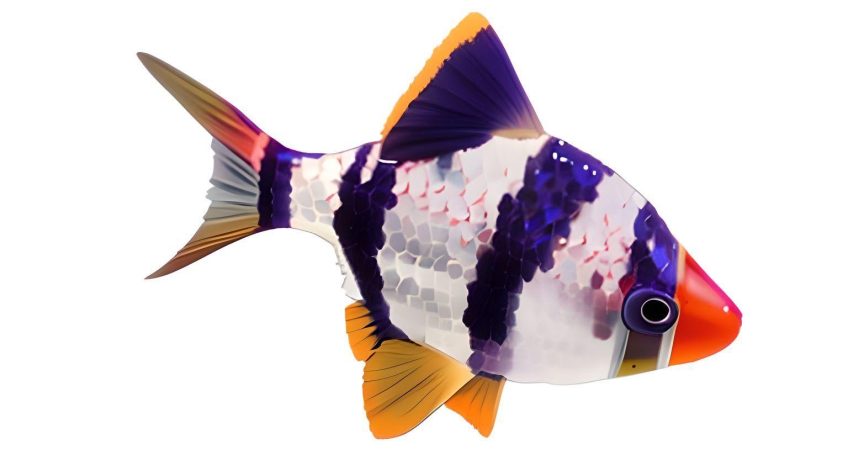Hi, Doc Johnson here. With a few words about one of my top five favorite community tank fish. That’s the “Tiger Barb” in any of it’s many colors.
They have a powder blue, a dark green, an all-black, normal, and even albino which is a delightful golden color.
My MAIN purpose in this article is to tell you the TWO most important things.
First: They have to eat practically constantly. If you’re forgetful and miss a day between feedings, it’s probable that your Tiger Barbs won’t last more than a couple months. I keep all my Tiger Barbs on an automatic feeder – with a tiny pellet food and they do AMAZINGLY.
Second: In tanks over 25-30 gallons their fin nipping is NOT that big of a deal. Even then, in a ten gallon tank their attentions are usually focused on each other, similar tetras, or anything with long(ish) fins.
Past these personal musings, I think you’ll like them. Just keep ‘em fed, and keep them in at least “trios” or even five-at-a-time depending on tank size. I my 55 gallon plant tank I have almost 15.
Now for the “meat and potatoes” of my article on Tiger barbs, barbus tetrazona
If you like this article, there’s a LOT more (more than a thousand) articles at
https://drjohnson.com on this and many other topics, written BY A VET and an accomplished aquarist – NOT written by ChatGPT – and there’s nothing wrong with ChatGPT as long as it’s proofed by an expert for errors. Thank you.
Title: Exploring the Fascinating World of Barbus Tetrazona: Natural Range, Habits, and Care
Introduction:
Barbus Tetrazona, commonly known as the Tiger Barb, is a captivating freshwater fish species that has gained popularity among aquarium enthusiasts. With its striking appearance and engaging behavior, the Tiger Barb adds vibrancy and liveliness to any aquatic environment. In this article, we will delve into the natural range of the Tiger Barb, its feeding habits, water quality preferences, aggression levels, suitable tank sizes, and uncover three interesting facts about this remarkable fish.
1. Natural Range:
The Tiger Barb is native to the waters of Southeast Asia, specifically in Indonesia, Malaysia, Sumatra, and Borneo. In these regions, it can be found inhabiting rivers, streams, and ponds with dense vegetation. These habitats are characterized by warm, clear waters, which serve as the ideal environment for the Tiger Barb to thrive.
2. Feeding Habits:
Tiger Barbs are omnivorous, which means they consume both plant matter and small invertebrates. In their natural habitat, they feed on algae, aquatic insects, small crustaceans, and plant material. When kept in an aquarium, a well-balanced diet should consist of high-quality flakes or pellets supplemented with occasional live or frozen foods like brine shrimp or bloodworms.
3. Water Quality Preferences:
Maintaining suitable water conditions is crucial for the health and well-being of Tiger Barbs. They prefer slightly acidic to neutral pH levels ranging from 6.0 to 7.5. The water temperature should be kept between 72°F and 79°F (22°C – 26°C). Tiger Barbs are adaptable and can tolerate a range of water hardness, although slightly soft to moderately hard water is generally preferred.
4. Aggression Levels:
Tiger Barbs are known for their feisty and active nature. They exhibit a hierarchical social structure, and within their own species, they can display aggression, especially if kept in small groups. It is recommended to keep Tiger Barbs in groups of at least six or more to help distribute aggression and prevent individual fish from being singled out. Mixing them with other fast-moving and similarly sized fish can also help reduce aggression.
5. Suitable Tank Size:
Providing ample space is essential when considering Tiger Barbs for your aquarium. A minimum tank size of 20 gallons (75 liters) is recommended for a small group of Tiger Barbs. They are active swimmers and appreciate a well-decorated tank with hiding spots and plenty of swimming space. Dense vegetation and open areas are both appreciated by these lively fish.
Three Interesting Facts:
a) Fin Nipping: Tiger Barbs are notorious for their fin-nipping tendencies, especially if kept in small groups or with slow-moving, long-finned species. Care should be taken when selecting tankmates to avoid fish with delicate fins.
b) Breeding Behavior: Male Tiger Barbs are known for their vibrant coloration and interesting courtship rituals. During breeding, males intensify their colors and chase the females, often leading to elaborate displays of courtship. Proper breeding conditions, such as densely planted tanks and soft water, can encourage successful reproduction.
c) Schooling Behavior: Tiger Barbs are highly social fish that thrive when kept in schools. They exhibit fascinating schooling behavior, swimming together in coordinated movements. Witnessing a group of Tiger Barbs in harmony is a captivating sight that adds to the allure of keeping them in your aquarium.
Conclusion:
The Tiger Barb, with its distinctive appearance and captivating behavior, has become a beloved species in the aquarium hobby. Understanding its natural range, feeding habits, water quality preferences, and social behavior is essential for providing the best care. By replicating their natural habitat, maintaining suitable water




















